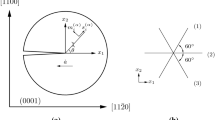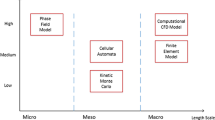Abstract
The kinetically driven growth instability in stressed solids has been a subject of recent investigation as there is an increasing interest in the effects of non-hydrostatic stresses on crystal growth processes. Recent experimental and modeling work using advanced numerical methods such as boundary element and level set methods have demonstrated that the effect of stress on the solid phase epitaxy (SPE) growth of crystalline silicon from the amorphous phase is responsible for the roughening of its amorphous–crystalline interface. Although our previous model (Phan et al., in Model Simul Mater Sci Eng, 9:309–325, 2001) has been able to explain the observed interfacial instability during the crystal growth of intrinsic silicon, it has not been very successful when extended to the SPE growth process of doped silicon. In an effort to identify the sources that may improve the accuracy and robustness of the previously proposed model, we present in this paper a new approach for modeling the crystal growth in stressed Si layers. The technique is based upon the coupling of a transition-state-theory-based model, a finite element model of the sequentially weak coupling analysis for fluid-solid interaction, and the marker particle method.
Similar content being viewed by others
References
Olson, G.L., Roth, J.A.: Solid phase epitaxy. In: Hurle D.T.J. (ed.) Handbook of Crystal Growth, vol. 3. Elsevier, North Holland (1994)
Larson L.E.: High-speed Si/SiGe technology for next generation wireless system applications. J. Vacuum Sci. Technol. B 16, 1541–1548 (1998)
Lu W., Koester S.J., Wang X.-W., Chu J.O., Ma T.-P., Adesida I.: Comparative study of self-aligned and non-self-aligned SiGe p-metal-oxide-semiconductor modulation-doped field effect transistors with nanometer gate lengths. J. Vacuum Sci. Technol. B 18, 3488–3492 (2000)
Presting H., Konle J., Hepp M., Kibbel H., Thonke K., Sauer R., Corbin E., Jaros M.: Novel mid-infrared silicon/germanium detector concepts. Opt. Eng. 39, 2624–2641 (2000)
Asaro R.J., Tiller W.A.: Interface morphology development during stress corrosion cracking: Part I: via surface diffusion. Metall. Trans 3, 1789–1796 (1972)
Grinfeld M.A.: Instability of the separation boundary between a nonhydrostatically stressed elastic body and a melt. Sov. Phys. Doklady 31, 831–835 (1986)
Srolovitz D.J.: On the stability of surfaces of stressed solids. Acta Metall. 37, 621–625 (1989)
Barvosa-Carter W., Aziz M.J., Gray L.J., Kaplan T.: Kinetically driven growth instability in stressed solids. Phys. Rev. Lett. 52, 1445–1448 (1998)
Sage J.F., Barvosa-Carter W., Aziz M.J.: Morphological instability of growth fronts due to stress-induced mobility variations. Appl. Phys. Lett. 77, 516–518 (2000)
Phan A.-V., Kaplan T., Gray L.J., Adalsteinsson D., Sethian J.A., Barvosa-Carter W., Aziz M.J.: Modelling a growth instability in a stressed solid. Model. Simul. Mater. Sci. Eng. 9, 309–325 (2001)
Voorhees, P.W., Aziz, M.J.: The effects of a stress-dependent mobility on interfacial stability. In: Proceedings of the Conference on Interfaces for the Twenty-First Century. Imperial College Press, London (2000)
Barvosa-Carter W., Aziz M.J., Phan A.-V., Kaplan T., Gray L.J.: Interfacial roughening during solid phase epitaxy: Interaction of dopant, stress, and anisotropy effects. J. Appl. Phys. 96, 5462–5368 (2004)
Sadd M.H.: Elasticity: Theory, Applications and Numerics. Elsevier, Boston (2005)
Seitz F., Turnbull D. (eds.): Solid State Physics, vol. 7. Academic Press, New York (1958)
Bathe K.-J.: Finite Element Procedures. Prentice-Hall, New Jersey (1997)
White F.M.: Viscous Fluid Flow, 3rd edn. McGraw-Hill, New York (2006)
Sethian J.A.: Curvature and the evolution of fronts. Commun. Math. Phys. 101, 487–499 (1985)
Author information
Authors and Affiliations
Corresponding author
Rights and permissions
About this article
Cite this article
Yellapragada, L., Phan, AV. & Kaplan, T. Fluid–solid interaction finite element modeling of a kinetically driven growth instability in stressed solids. Arch Appl Mech 79, 457–467 (2009). https://doi.org/10.1007/s00419-008-0244-3
Received:
Accepted:
Published:
Issue Date:
DOI: https://doi.org/10.1007/s00419-008-0244-3




